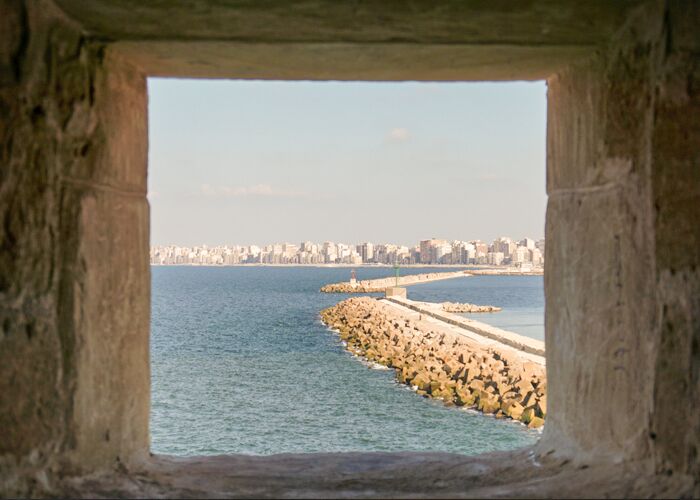Egypt’s Alexandria is a city.
Included are the following topics:
Highlights and Geographical Location of Alexandria, the Pearl of the Mediterranean
Ancient Greek and Roman Artifacts on Display in the Citadel of Qaitbay
The “Pearl of the Orient” in the Mediterranean Sea
Alexandria is distinguished by a 20-kilometer-long palm-tree-lined esplanade and boulevards, elegant hotels, extensive sections of excellent sandy beach, and beautiful gardens. Since it is located in the Middle East, it is often referred to as one of the world’s most beautiful summer vacation spots.
It has a Mediterranean character because of its cultural past, climate (warm summers, temperate winters, and beautiful spring and autumn months), and cosmopolitan atmosphere. Alexandria is known as the ‘Pearl of the Mediterranean’ for its exquisite beauty.
Geographical location and most interesting aspects of Alexandria
In Alexandria, Egypt’s second-largest city, there are over four million inhabitants, making it Egypt’s primary seaport and the centre of the country’s nautical sector. It is also one of Egypt’s oldest cities, and it is situated roughly 225 kilometres northwest of the capital.
According to historical records, Alexander the Great established Alexandria in 332 BC on the site of a little village called as Rhakotis. He aspired to create a capital city that would stand as a testament to his reign’s achievements for generations to come.
Alexandria was Egypt’s capital for more than a thousand years, and its strategic location between the Mediterranean and the Red Sea contributed to its prosperity.
Alexandria served as Egypt’s cultural and economic capital for centuries. As a consequence, it became a major intellectual centre in ancient times and continues to be so even now.
On a hill overlooking the sea sits the beautiful and historic Montazah Palace, a must-see sight for visitors. It was formerly the summer house of the Egyptian royal family, and it now serves as a museum devoted to them. Built in the Turkish and Italian architectural styles, it is one of Alexandria’s most attractive gardens. Stop visit if you get the chance; they’re open to the public and free of charge.
Alexandria has some of Egypt’s best diving spots as well as some of the most gorgeous beaches in the Mediterranean, which is why so many visitors flock there. Beaches such as Al-Ma’moura, Mandara, Al-Assafrah, Mami and Sidi Bishr and Montazah, as well as Gleem and Cleopatra are some of the most popular in the region. A seaside avenue, the corniche, is where you’ll find all of them.
Qaitbay Castle
Qaitbay Citadel, a 15th century citadel built on the site of the Lighthouse of Alexandria, one of the Seven Wonders of the Ancient World, is a must-visit in Alexandria. An old lighthouse built on a harbour island in the third century BC is said to have provided some of the stones for this one, according to mythology.
A new piece of ancient stone has recently been unearthed in the harbour, which is believed to have been used in the building of the lighthouse.
The Al-Mursi Abul Abbas Mosque, which has a towering minaret and domes that dominate the city’s skyline, and the Al-Attareen Mosque, which was erected in the 14th century, are the two most notable mosques in the city.
The Graeco-Roman World Museum
There are some 332 BC artefacts found at the Graeco-Roman Museum, located in the heart of Alexandria today, which are part of a spectacular collection of over 40,000 items. Weekends and holidays are ideal times to visit the museum since it is accessible to the public.
One of Alexandria’s most prominent tourist attractions, the museum opened its doors in the 19th century and quickly established itself as a significant exhibitor of ancient antiquities.
The ancient catacombs at Kom el Shoqafa, which contain a mixture of Pharaonic and Greco Roman art, the Al-Shatby Necropolis site, which contains a series of tombs, and the Al-Shatby Necropolis tombs are just a few of the many archaeological sites in Alexandria. In addition to historical sites, Alexandria is home to numerous archaeological sites.
As a reminder of the city’s rich heritage, it also provides modern services and facilities to its residents and visitors.
The Bibliotheca Alexandrina, a renowned library and cultural institution, is a vivid example of this, since it was inaugurated earlier this year. At the time of its creation, it was considered the largest library in the ancient world. It is built near the site of the old Library of Alexandria, which goes back to the 3rd century.

